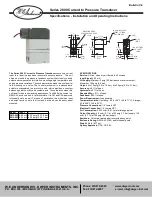
Rev. 1.10
188
October 23, 2020
Rev. 1.10
189
October 23, 2020
BC66F5652
2.4GHz RF Transceiver A/D Flash MCU
BC66F5652
2.4GHz RF Transceiver A/D Flash MCU
UART Transfer Interrupt
The UART Transfer Interrupt is controlled by several UART transfer conditions. When one of these
conditions occurs, an interrupt pulse will be generated to get the attention of the microcontroller.
These conditions are a transmitter data register empty, transmitter idle, receiver data available,
receiver overrun, address detect and an RX pin wake-up. To allow the program to branch to its
respective interrupt vector address, the global interrupt enable bit, EMI, and UART Interrupt
enable bit, URE, must first be set. When the interrupt is enabled, the stack is not full and any of the
conditions described above occurs, a subroutine call to the UART Interrupt vector, will take place.
When the interrupt is serviced, the UART Interrupt flag, URF, will be automatically cleared. The
EMI bit will also be automatically cleared to disable other interrupts.
LVD Interrupt
The Low Voltage Detector Interrupt is contained within the Multi-function Interrupt. An LVD
Interrupt request will take place when the LVD Interrupt request flag, LVF, is set, which occurs
when the Low Voltage Detector function detects a low power supply voltage. To allow the program
to branch to its respective interrupt vector address, the global interrupt enable bit, EMI, Low Voltage
Interrupt enable bit, LVE, and associated Multi-function interrupt enable bit, must first be set. When
the interrupt is enabled, the stack is not full and a low voltage condition occurs, a subroutine call to
the Multi-function Interrupt vector, will take place. When the Low Voltage Interrupt is serviced, the
EMI bit will be automatically cleared to disable other interrupts. However, only the Multi-function
interrupt request flag will be also automatically cleared. As the LVF flag will not be automatically
cleared, it has to be cleared by the application program.
EEPROM Interrupt
The EEPROM Interrupt is contained within the Multi-function Interrupt. An EEPROM Interrupt
request will take place when the EEPROM Interrupt request flag, DEF, is set, which occurs when
an EEPROM Erase or Write cycle ends. To allow the program to branch to its respective interrupt
vector address, the global interrupt enable bit, EMI, EEPROM Interrupt enable bit, DEE, and
associated Multi-function interrupt enable bit must first be set. When the interrupt is enabled, the
stack is not full and an EEPROM Erase or Write cycle ends, a subroutine call to the respective
Multi-function Interrupt vector will take place. When the EEPROM Write Interrupt is serviced, the
EMI bit will be automatically cleared to disable other interrupts. However, only the Multi-function
interrupt request flag will be automatically cleared. As the DEF flag will not be automatically
cleared, it has to be cleared by the application program.
Interrupt Wake-up Function
Each of the interrupt functions has the capability of waking up the microcontroller when in the
SLEEP or IDLE Mode. A wake-up is generated when an interrupt request flag changes from low to
high and is independent of whether the interrupt is enabled or not. Therefore, even though the device
is in the SLEEP or IDLE Mode and its system oscillator stopped, situations such as external edge
transitions on the external interrupt pins, a low power supply voltage or comparator input change
may cause their respective interrupt flag to be set high and consequently generate an interrupt. Care
must therefore be taken if spurious wake-up situations are to be avoided. If an interrupt wake-up
function is to be disabled then the corresponding interrupt request flag should be set high before the
device enters the SLEEP or IDLE Mode. The interrupt enable bits have no effect on the interrupt
wake-up function.
















































